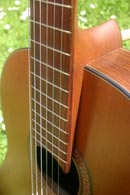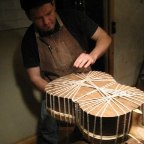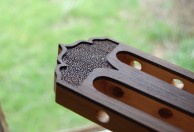Welcome to one of the most active flamenco sites on the Internet. Guests can read most posts but if you want to participate click here to register.
This site is dedicated to the memory of Paco de Lucía, Ron Mitchell, Guy Williams, Linda Elvira, Philip John Lee, Craig Eros, Ben Woods, David Serva and Tom Blackshear who went ahead of us.
We receive 12,200 visitors a month from 200 countries and 1.7 million page impressions a year. To advertise on this site please contact us.
|

|
|
The difference 1mm can make
|
You are logged in as Guest
|
|
Users viewing this topic: none
|
|
Login  | |
|

  
Anders Eliasson
Posts: 5780
Joined: Oct. 18 2006

|
 RE: The difference 1mm can make (in reply to yourwhathurts69) RE: The difference 1mm can make (in reply to yourwhathurts69)
|
|
|
Again, you guys are getting completely winded up talking about tenth of milimeters. You sound like Ruben Diaz. 
Two things. A to low setup, kills sound and we all want it as low as possible.
But there are so many factors involved in making a comfortable, fast and well sounding guitar that works in different playing situations. One of them is low setup, but its only one of them.
I prefer lower than 3mm and normally dingo a setup in the 2,6 - 2,8mm range, but if the rest of the guitar is spot on, its not something I´m religious about and when I talk with pro players, they agree. Its the feel that matters. And some pro players actually need a setup higher than 3mm because of their violent tecnique... There´s a huge difference between sitting in your bedroom and playing in a noisy peña. In a noisy situation a very low setup means a totally dead sounding guitar
Also, the pulsation, feel and stiffness of a guitar determinates the height of the setup. A very stiff guitar can be set up lower than a looser one, but it might feel a lot less comfortable and you might actually get the idea that it has a higher setup than it actually has.
My swing around guitar is one of my first builds. I never sold it because it had some "issues" such as a slightly wrong neckangle. I cannot get it lower than a tad over 3mm, 6th string, 12 fret without sacrificing other things. But the guitar has a very nice pulsation and it has devellopped a very good old school sound. A lot of local players here have played it. Including some pro ones. They all realy like it, want to buy it (cheap  ) and NOONE has ever talked about its relatively high setup. The guitar is simply has a very nice balance all over. ) and NOONE has ever talked about its relatively high setup. The guitar is simply has a very nice balance all over.
_____________________________
Blog: http://news-from-the-workshop.blogspot.com/
|
|
|
|
REPORT THIS POST AS INAPPROPRIATE |
Date Oct. 14 2011 8:00:56
 |
|

   
Peter Tsiorba
Posts: 130
Joined: Oct. 27 2009
From: Portland, Oregon Pacific Northwest

|
 RE: The difference 1mm can make (in reply to yourwhathurts69) RE: The difference 1mm can make (in reply to yourwhathurts69)
|
|
|
Well guys, I must be one of those luthiers who does not prefer the 3mm or higher set-ups. I shoot for 2.5mm or under, sometimes going down to 2mm or a hair under for those who require it.
My logic is this: raising the action is not that difficult. Cut a new (higher) saddle, and you are done! Heck, while you are at it, make the action 4.5mm if you wish, and see how the guitar sounds.
On the other hand, if one decides to go low, there are many other aspects of the guitar set-up that have to be just right. Specifically, fret work has to be very cleanly and precisely done. That includes the right amount of relief, lest the guitar buzz like crazy. The bridge has to be designed in such a way that even with a low action there is enough string break angle over the saddle. In practice, for me that means placing string holes at the lowest possible position.
I personally have not met too many flamenco players who would accept a 3mm high action. Maybe your experience is different. Obviously, if your customers want it that high, then there is no problem. On the other hand, the guitars built for 3mm high actions are not always easily converted down to 2mm one. Frequently, previously inconsequential details come to fore, and become problems, requiring a remedy before the new, low set-up is possible.
So, my approach has been to design the system to work to a tighter tolerance, and then increase the "slop" if necessary. At that point, going up is easy.
_____________________________
Peter Tsiorba
Classical-Flamenco-Guitars
tsiorba.com
|
|
|
|
REPORT THIS POST AS INAPPROPRIATE |
Date Oct. 14 2011 21:40:58
 |
|

   
Peter Tsiorba
Posts: 130
Joined: Oct. 27 2009
From: Portland, Oregon Pacific Northwest

|
 RE: The difference 1mm can make (in reply to Anders Eliasson) RE: The difference 1mm can make (in reply to Anders Eliasson)
|
|
|
quote:
ORIGINAL: Anders Eliasson
But there are so many factors involved in making a comfortable, fast and well sounding guitar that works in different playing situations. One of them is low setup, but its only one of them.
Anders,
I agree with you, and indeed higher set-up is sometimes appropriate, and is the best for certain players. The "feel" of the guitar, as you have pointed out, is indeed a culmination of many, many nuances, ideally all working together.
_____________________________
Peter Tsiorba
Classical-Flamenco-Guitars
tsiorba.com
|
|
|
|
REPORT THIS POST AS INAPPROPRIATE |
Date Oct. 14 2011 22:02:04
 |
|

  
Anders Eliasson
Posts: 5780
Joined: Oct. 18 2006

|
 RE: The difference 1mm can make (in reply to Peter Tsiorba) RE: The difference 1mm can make (in reply to Peter Tsiorba)
|
|
|
quote:
Well guys, I must be one of those luthiers who does not prefer the 3mm or higher set-ups.
You are turning the discussion the wrong way. No luthier on this thread has said that they prefered an action higher than 3mm. So please, dont try to create the idea that you are the only one making low setups. Because, we are ALL looking for the most comfortable setup that´ll work in REAL flamenco environments..
Also, I´m 99% sure that one of your 2mm action guitars wouldnt work at all here in Andalucia. They would just say sploink, rattle and buzz. I dont know how and where your clients and flamenco guitar friends play, but I know how Andalucian flamenco guitarist play. Thay have been raised here and have all been out playing in very noisy environments. This creates a certain way of playing, which is tough. But its THE flamenco sound and it has little to do with bedroom flamenco which can be played with a lot lower setup.
Before, I always adjusted my guitars to work at around 2,4 - 2,5mm and was happy when playing alone in a quiet environment. But EVERYTIME I took one of these guitars out to a local peña or juerga, I had to go go back and raise the action slightly (still below 3mm)
The guitar I play the most right now has around 2,6mm and its an absolute minimum. It has been tested in different places and by different players. If only testing it alone here in my workshop or my bedroom, it would have a lower action, but I would know that it would be "cheating"
_____________________________
Blog: http://news-from-the-workshop.blogspot.com/
|
|
|
|
REPORT THIS POST AS INAPPROPRIATE |
Date Oct. 15 2011 7:43:16
 |
|

   
Ricardo
Posts: 14801
Joined: Dec. 14 2004
From: Washington DC

|
 RE: The difference 1mm can make (in reply to yourwhathurts69) RE: The difference 1mm can make (in reply to yourwhathurts69)
|
|
|
No disrespect to anyone, but whenever action argument comes up, no one mentions the bridge which is most important to us flamenco players. We can't use a guitar, no matter what the 12th fret is at, if the bridge is too high. And it seems few luthiers get the point about how we prefer it, as I have seen SO MANY flamenco guitars with a high bone and all this amazing important break angle over it. Sorry, but when I see a guitar that has a low bridge it usually feels good to play because of the right hand, not the left, and it is obvious with these instruments, that the luthier "gets it"....but it is certainly more rare. In short, we forgive a higher then perfectly comfy 12th fret action if the bridge feels right when we strum.
On that note, I got to try an Anders blanca in Spain, and a negra locally here, and I admit, HE gets it somehow....
No special advert here, I am just frustrated about how many people are concerned with the 12th fret issue in general.
_____________________________
CD's and transcriptions available here:
www.ricardomarlow.com
|
|
|
|
REPORT THIS POST AS INAPPROPRIATE |
Date Oct. 15 2011 8:12:36
 |
|

   
estebanana
Posts: 9351
Joined: Oct. 16 2009

|
 RE: The difference 1mm can make (in reply to Ricardo) RE: The difference 1mm can make (in reply to Ricardo)
|
|
|
quote:
Sorry, but when I see a guitar that has a low bridge it usually feels good to play because of the right hand, not the left, and it is obvious with these instruments, that the luthier "gets it"....but it is certainly more rare. In short, we forgive a higher then perfectly comfy 12th fret action if the bridge feels right when we strum.
Exaclty. On a flamenco guitar you work for the action at the saddle height, the rest follows. In my way of thinking about it. The reason I did not say this is because I think it's so obvious and I've played in enough cuadro situations myself to know that zone. (not saying I'm a good player by any means)
Again at saddle height there is no single magic number, but you have a zone to work in. I consider that zone to be between between 7mm to 10mm with 8mm being an average for most guitars. But the crucial thing is how does the right hand feel and how does saddle height effect string tension and it's relationship to rasgueado tempo?
My teacher Eugene Clark has his own way of expressing what in Spain they call 'Pulsation'. He calls it String Tempo. By string tempo he means the effect the saddle height has on tension, power and the speed at which the string recovers from being pushed. If I am correct in Spain they call that whole relationship 'pulsation'. I think they are talking about the same set of action and reactions in the string because Clark's concept of 'string tempo' includes the right hand feeling and ability to move through the set of strings at a tension that will recover at a speed that allows the player to do powerful rasgueado yet not have to plow through tough string feeling.
I may be off base with this analogy and I'm sure Anders could hone it down finer and say what is intrinsic to both the Spanish idea of 'pulsation' and Clark's idea of 'string tempo'. The way Clark came to this language is that in the early 1960's when he was set up in San Francisco as a professional guitar maker he did a lot of adjustment and repair work on Spanish guitars that were in circulation as players instruments. Those era guitars are mainly in collections or not being played on stage today, but in 1964 he said it was common to have Barbero, Domingo Esteso, Fleta et al guitars moving though his shop. He told me that many of the flamenco guitars in that era were coming from Span with higher set ups and that the lower /lowest actions were the exception not the rule. He told me he would consistently see saddle height of 10mm - 9 mm on flamenco guitars. The 12th fret string height was not the issue, it was the saddle and it's relation to this idea that the guitar has a 'tempo' ( pulsation) of it's own and this tempo of the string can be regulated and changed by saddle height.
I think he was searching for language in English to explain what he observed and what the Spanish makers understood to be pulsation. He also has another term called 'Forcing Power'. Forcing Power is the idea that a guitar can be pushed hard over the sound hole and the guitar will not 'bottom out'. This is his benchmark of a guitar that can be played behind the sound hole in front of the bridge with a comfortable action and still not bottom out. If the guitar has this strength built into it you may lower the action and the guitar will stay powerful. I think the idea of forcing power is what in Spain they look for in a guitar that has the ability to be played in noisy situations and still have power in reserve.
This is to say that some people here in the US also got this pulsation concept early on and worked with the elements of power and saddle height to make guitars that have be playable saddle height yet have power and projection. The other maker who is more reclusive and mainly known locally, but is one of the best flamenco guitar makers in the US is Chris Burkov. He and others of his generation, ten years younger than Clark, including Lester DeVoe understand the pulsation/string tempo idea profoundly. I know in other areas of the country there were people building, Blackshear, Lucian Barnes and Warren White who also intuited and studied this relationship between power, projection and right hand feel. Only many of those US makers who "got it" were eclipsed by player prejudice towards instruments from Spain. So many of them did not get the credit they deserved. And who can blame the players for in those days the economic factor of buying a guitar in Spain for a third of the price of a domestic guitar must have been quite persuasive.
The idea of saddle right hand compatibility has been in the air here for a very long time and it is something for me that is an 'a priori'; so obvious that it does not need to be said. But I guess it does need to be said. The only problem I see with Clark's history is that anomalies pop up, like drawings of Barbero's with super low actions, or stories of Diego del Gastor playing guitars with super low action. These attributions are curious, I've come to the conclusion that action height is a thing that takes on cyclic trends according to who the best players of the day are.
When people speak of 'old time flamenco guitar sound' in my mind that equates to higher actions. I hear it on the old records that those guitars sound to me like they are set up much higher and cleaner than what was trendy in the 1970's -80s - But I hear Sabicas playing on a low action, yet cleanly. I think the trend changes, but always from the earliest days to now there were those who favored higher actions if they were powerful players. And those who used lower actions who seemed to have a touch to make those actions work in early recording and playing situations.
Personally I like a clearer less jangly sound, I'm more interested in power and following my teachers lead in making instruments that have power in reserve while at the same time having that right hand feel that makes rasgueados feel like butter. What I would really like to know more about is how the great players of history from Molina to Morao thought about right hand string tempo or pulsation and what was acceptable to them in saddle height. Or do/did they even care? It's probably counter productive from a business stand point to challenge customers on action height, but I'm more interested in the over all investigation of the guitar and the set ups of seminal players in relation to trends of what players want. I think it serves the guitar and the buyer in the end.
If anyone has real information about important guitarists and the set ups they prefer I would really like to hear about this. But don't try to blow any anecdotal smoke up my ass.
_____________________________
https://www.stephenfaulkguitars.com
|
|
|
|
REPORT THIS POST AS INAPPROPRIATE |
Date Oct. 15 2011 19:14:59
 |
|

   
Peter Tsiorba
Posts: 130
Joined: Oct. 27 2009
From: Portland, Oregon Pacific Northwest

|
 RE: The difference 1mm can make (in reply to Anders Eliasson) RE: The difference 1mm can make (in reply to Anders Eliasson)
|
|
|
quote:
ORIGINAL: Anders Eliasson
You are turning the discussion the wrong way... So please, dont try to create the idea that you are the only one making low setups...
Also, I´m 99% sure that one of your 2mm action guitars wouldnt work at all here in Andalucia. They would just say sploink, rattle and buzz..
Let's see....Anders....
Boy, I must have touched off a nerve somewhere. In one post, it became obvious (to Anders) that I steer the discussion in the wrong direction, make claims, create guitars for bedroom flamenco, and issue statements that are pure blah blah?! Whoaa! I guess at least I don't need to read between the lines! Feeling cranky and undiplomatic?
In any event, if you took offense at my post, I offer to you my assurance that I did not wish to put you or any other luthier down. Peace?
_____________________________
Peter Tsiorba
Classical-Flamenco-Guitars
tsiorba.com
|
|
|
|
REPORT THIS POST AS INAPPROPRIATE |
Date Oct. 15 2011 21:29:23
 |
|

   
Peter Tsiorba
Posts: 130
Joined: Oct. 27 2009
From: Portland, Oregon Pacific Northwest

|
 RE: The difference 1mm can make (in reply to Anders Eliasson) RE: The difference 1mm can make (in reply to Anders Eliasson)
|
|
|
quote:
ORIGINAL: Anders Eliasson
quote:
On the other hand, the guitars built for 3mm high actions are not always easily converted down to 2mm one. Frequently, previously inconsequential details come to fore, and become problems, requiring a remedy before the new, low set-up is possible.
So, my approach has been to design the system to work to a tighter tolerance, and then increase the "slop" if necessary. At that point, going up is easy.
Unless you give a very specific explanation of what you are trying to say here, I will consider this statement pure Blah - blah.
What I meant is that with higher action, a luthier (me included) could get away with less precise fret work. When the action goes down quite a bit, it takes a lot more care to "dial-in" the fretwork to a level that would be buzz-free. That was the main point, although there are a few other details concerning the bridge/saddle.
_____________________________
Peter Tsiorba
Classical-Flamenco-Guitars
tsiorba.com
|
|
|
|
REPORT THIS POST AS INAPPROPRIATE |
Date Oct. 15 2011 21:37:57
 |
|

  
Anders Eliasson
Posts: 5780
Joined: Oct. 18 2006

|
 RE: The difference 1mm can make (in reply to yourwhathurts69) RE: The difference 1mm can make (in reply to yourwhathurts69)
|
|
|
quote:
What I meant is that with higher action, a luthier (me included) could get away with less precise fret work. When the action goes down quite a bit, it takes a lot more care to "dial-in" the fretwork to a level that would be buzz-free. That was the main point, although there are a few other details concerning the bridge/saddle.
Thanks for explaining.
So what you call "my approach has been to design the system to work to a tighter tolerance" is just standard fret work? Something we all need to do in order to make a good setup. There arent really any secrets in that work. But the more flamenco guitars you have done frets on, the better you get. Being your own builds or refretting etc.
Besides, the term buzz free is describing something very relative. You can have players making very little buzz and others capable of buzzing on more or less whatever setup.
And finally, I didnt say that YOU made bedroom flamenco guitars. But you read it like that. I make bedroom setups for the players that want that, and I always tell them that its not what I would play myself and that it has some negative effects on sound, volume, projection, feel, pulsation, liveliness of the guitar etc.
_____________________________
Blog: http://news-from-the-workshop.blogspot.com/
|
|
|
|
REPORT THIS POST AS INAPPROPRIATE |
Date Oct. 16 2011 10:37:48
 |
|

   
Steve Wright
Posts: 120
Joined: May 11 2011
From: Scotland Fife UK

|
 RE: The difference 1mm can make (in reply to Ricardo) RE: The difference 1mm can make (in reply to Ricardo)
|
|
|
quote:
Whenever action argument comes up, no one mentions the bridge which is most important to us flamenco players. We can't use a guitar, no matter what the 12th fret is at, if the bridge is too high. When I see a guitar that has a low bridge it usually feels good to play because of the right hand, not the left. In short, we forgive a higher then perfectly comfy 12th fret action if the bridge feels right when we strum.
I am just frustrated about how many people are concerned with the 12th fret issue in general.
Hi Ricardo, I think we all too often jump down each other's throats because we can't express tone very well on a forum. It is the nature of the beast. Your comment is exactly what people like me need to hear - balanced with the comments of Anders, Steven and Peter. Many of us are translating. I used to translate from Piano to guitar. Now I'm translating from electric to nylon string, not realising the golf between classical and flamenco. so your comment is very useful - and I don't think we are overly concerned about the 12th fret - it's just that we don't know better. I want to develop technique and unless the tool is right on left and right hand, I can't hope to come near to flamenco.
_____________________________
Rhythm, grace & passion. El ritmo, gracia & la pasión
Be the change you want to see in this world - Gandhi
http://www.youtube.com/user/FusionMusic1000
|
|
|
|
REPORT THIS POST AS INAPPROPRIATE |
Date Oct. 16 2011 14:23:32
 |
|
 New Messages New Messages |
 No New Messages No New Messages |
 Hot Topic w/ New Messages Hot Topic w/ New Messages |
 Hot Topic w/o New Messages Hot Topic w/o New Messages |
 Locked w/ New Messages Locked w/ New Messages |
 Locked w/o New Messages Locked w/o New Messages |
|
 Post New Thread
Post New Thread
 Reply to Message
Reply to Message
 Post New Poll
Post New Poll
 Submit Vote
Submit Vote
 Delete My Own Post
Delete My Own Post
 Delete My Own Thread
Delete My Own Thread
 Rate Posts
Rate Posts
|
|
|
Forum Software powered by ASP Playground Advanced Edition 2.0.5
Copyright © 2000 - 2003 ASPPlayground.NET |
0.1098633 secs.
|


 Printable Version
Printable Version












 New Messages
New Messages No New Messages
No New Messages Hot Topic w/ New Messages
Hot Topic w/ New Messages Hot Topic w/o New Messages
Hot Topic w/o New Messages Locked w/ New Messages
Locked w/ New Messages Locked w/o New Messages
Locked w/o New Messages Post New Thread
Post New Thread